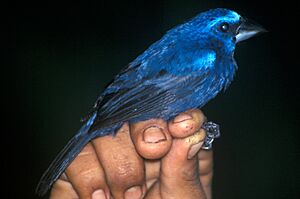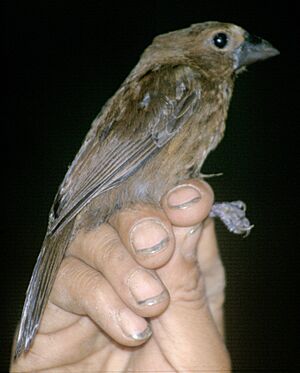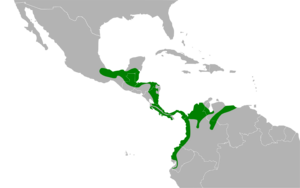Blue-black grosbeak facts for kids
Quick facts for kids Blue-black grosbeak |
|
|---|---|
 |
|
 |
|
| Male (above) and female (below) | |
| Conservation status | |
| Scientific classification | |
| Genus: |
Cyanoloxia
|
| Species: |
cyanoides
|
 |
|
| Synonyms | |
|
Cyanoloxia cyanoides |
|
The blue-black grosbeak (scientific name: Cyanoloxia cyanoides) is a type of songbird. It belongs to the Cardinalidae family, which includes cardinals and buntings.
Experts from the American Ornithological Society now place this bird in the genus Cyanoloxia. In 2018, they decided that a group of these birds living in the eastern lowlands was actually a different species. This new species is called the Amazonian grosbeak (Cyanoloxia rothschildii).
Contents
About the Blue-Black Grosbeak
How Scientists Classify Them
The blue-black grosbeak is part of the Cardinalidae family. This family is within the order Passeriformes, which includes many types of perching birds.
Even though some people still put it in the genus Cyanocompsa, scientists found that this group was not organized correctly. They discovered it included birds that should be in the genus Amaurospiza and Cyanoloxia.
There are three main types, or subspecies, of the blue-black grosbeak:
- Cyanoloxia cyanoides cyanoides
- Cyanoloxia cyanoides caerulescens
- Cyanoloxia cyanoides concreta
These three subspecies look quite similar. However, there are small differences. Males of C.c. concreta are the darkest and largest. C.c. caerulescens is next in size and color. Finally, C.c. cyanoides is the smallest and has the brightest blue feathers.
There used to be a fourth subspecies, C.c. rothschildii. This was the only one found east of the Andes mountains. But after studying its genetics, scientists decided C.c. rothschildii was different enough to be its own species. It is now known as the Amazonian grosbeak (Cyanoloxia rothschildii).
What They Look Like
Blue-black grosbeaks look different depending on if they are male or female. This is called being sexually dimorphic.
Female birds have dark brown feathers. Sometimes, their feathers can have a slight reddish color.
Male birds are dark blue. They have lighter blue "eyebrows" above their eyes. They also have light blue patches on their shoulders and wings. The area just above their beak, called the forehead, is also a lighter shade of blue.
Their Calls and Songs
It can be hard to spot blue-black grosbeaks. They like to stay hidden in thick plants. So, you often know they are around only by their sounds.
Their song has about six whistles. The pitch of the whistles goes down as they sing. It usually ends with sounds like "seee seee sewee suwee sweet suuu." The songs are a bit different among the three subspecies.
Their call is a sharp "shek" or "chit." They often repeat this call many times.
Where They Live
The blue-black grosbeak lives in parts of Central and South America. You can find them in these countries:
The subspecies C.c. caerulescens and C.c. concreta live in Mexico and Central America. The subspecies C.c. cyanoides can be found from Panama down to northern South America.
These birds prefer places with lots of tall trees and thick plants. This gives them good places to hide. You might also find them at the edges of broadleaf forests.
How They Behave
Breeding and Nests
Blue-black grosbeaks build small, cup-shaped nests. They usually lay two eggs at a time.
Their breeding season happens during the spring and summer months. The exact time of peak breeding can be a little different depending on where the birds live.
What They Eat
Blue-black grosbeaks eat both plants and insects. This means they are omnivores. They have been seen eating seeds and fruits. They also eat insects like ants and caterpillars. When they eat seeds, they crush them first.
Gallery





